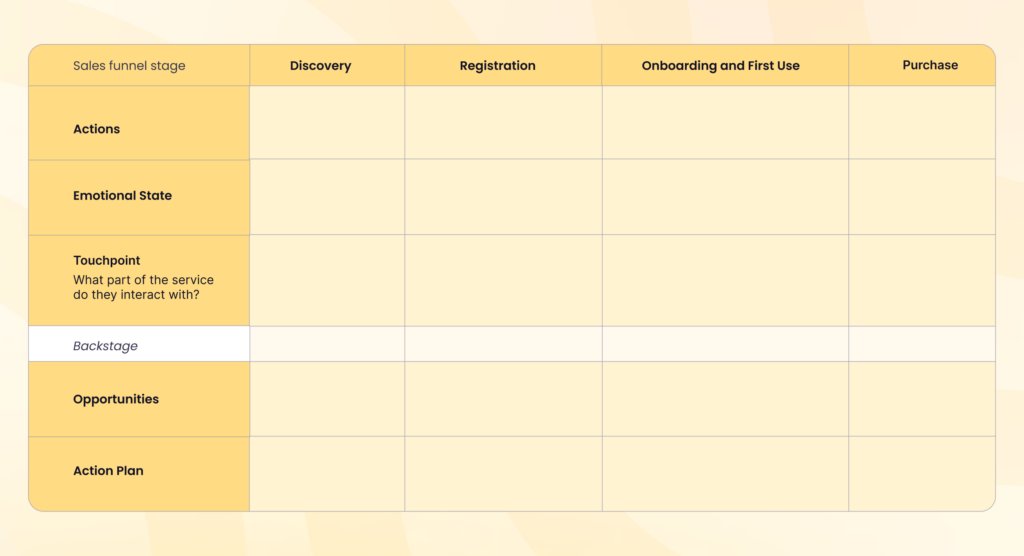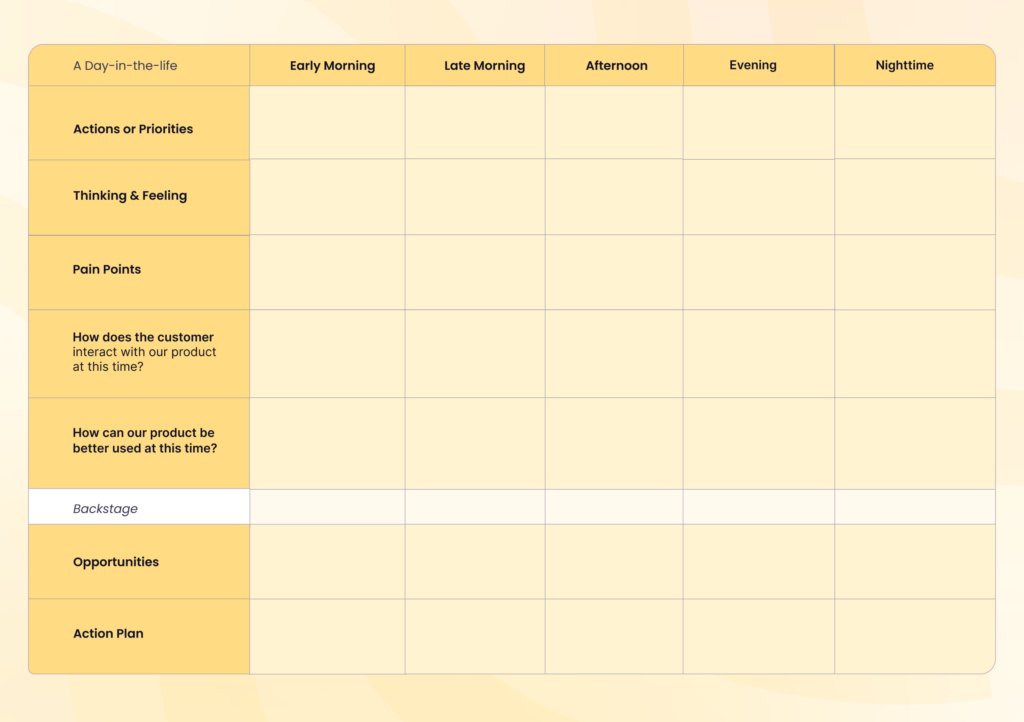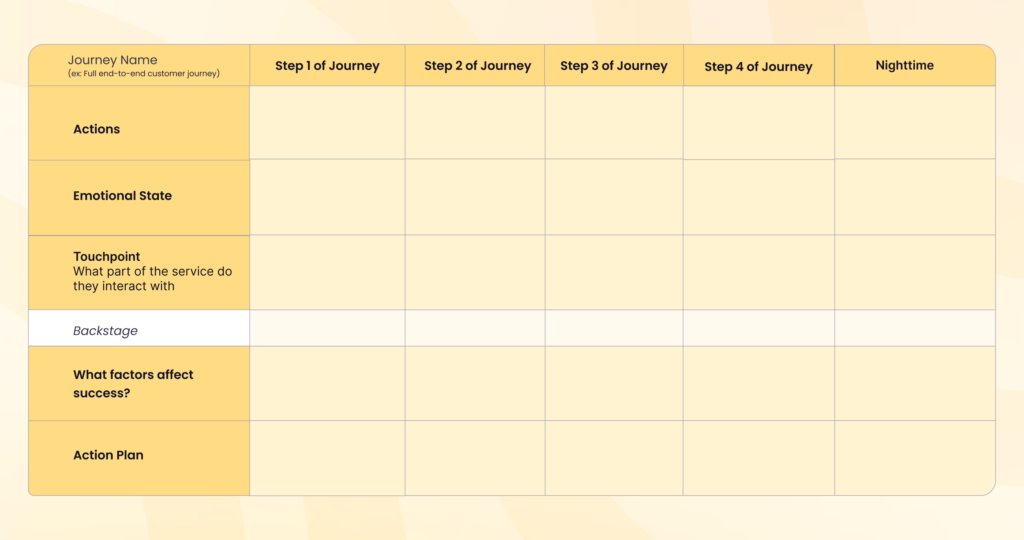
Table of contents
10,000+ teams use Hiver to delight their customers!

A Detailed Guide to Customer Journey Mapping

Table of contents
Customer journey mapping. Sounds like a fun exercise, but is it actually helpful?
Done well, a customer journey map can be many things: a blueprint for business decisions, a shared vision for your team, and a yardstick to measure progress.
In this piece, we’ll unpack how you can create a customer journey map that’s actually useful, and best practices to make it more powerful.
Let’s go.
Table of Contents
- What is customer journey mapping?
- How to Create a Customer Journey Map
- Types of customer journey maps
- Four benefits of customer journey mapping
- Three best practices for customer journey mapping
- Customer journey maps are the path to customer-centricity
What is customer journey mapping?
A customer journey map helps you understand how customers experience your product.
You trace the customer’s footsteps throughout your product and use feedback and other qualitative data to identify points of friction and delight. The goal is to enhance the overall product experience.
As per one report, customer experience beats price when it comes to buying decisions. Another PWC report found that 73% of customers consider customer experience as a key factor when purchasing a product.
Customer journey maps help you take that first step towards delivering a great experience.
The process of creating a strong brand identity starts with marking different customer touchpoints, including your website, landing pages, product pages, help documents, payment gateway, social media, chat, or phone support. This includes designing a visually appealing logo that represents your brand and can be displayed prominently on all these touchpoints, especially on your website and social media profiles. A well-crafted logo design can help increase brand recognition and credibility, and make your business stand out from the competition.
Then, at each stage, you label customer emotions based on feedback from surveys, social media, and support.
All of this comes together visually in a customer journey map that provides a complete picture of the customer’s frustrations and wins.
How to Create a Customer Journey Map
We’ve seen why customer journey maps are important. But how do you actually build one that’s a source of truth for all teams, and not another vanity project?
Take a look.
1. Define the scope of your customer journey map
Before you start lining up the wall with sticky notes, you’ll need to ask a few questions.
- What’s the main goal of creating the map? Identify customer frustrations, discover product problems, or innovate?
- Which buyer segment are you targeting? There are many ways to segment buyers: frequency of purchase, value to your business, demographics, and professional status.
- How do you plan to implement changes? Without a solid action plan, customer journey mapping is futile.
Once you’ve set goals and objectives for your map, it’s time to get down to business.
2. Compile customer data
Depending on the buyer segment or persona you choose to focus on for your map, it’s time to go a-fishing for data and feedback.
What are we looking for? The different routes customers take inside your product, the ways they find your brand, and clues into how they feel while using your product. Here are some reliable sources to find this information:
- Website: Your website is a treasure chest of customer data. It helps you drill into user flows, most visited pages, points of entry, and exit pages. For example, WordPress website development focused on customer databases enables you to keep track of client information efficiently, helping you to identify pages that don’t get as much attention.
- Surveys:These help you learn about why customers may be frustrated with your product. You may also find useful nuggets for improving your product in some responses.
- Social media: If you have a bustling social media presence, make a note of the way customers interact with your brand and the most common complaints you see. Remember, most social media criticisms are escalations. They happen because customers waited too long to get a response from your support team or failed to get one at all. So pay careful attention to these.
- Customer service requests: The last and final piece of the puzzle is customer support data. If you look closely, you’ll find a can of broken features, inefficiencies, feature requests, and customer struggles spill over.
If you use customer support software such as Hiver, you can easily create detailed reports to reveal trends in your customer service data.
3. List all possible customer touch points
Let’s say you run an e-commerce website that sells second-hand furniture. Some users may land up on your website through a social media post. These customers may casually browse through your product catalog and sign up for your newsletter.
A small number of those who sign up may open your newsletter. From there, they’ll probably click on a sale item and proceed to purchase. But, the journey isn’t over yet. The updates they receive on their purchase and the feedback they leave, if any, counts too.
Each of these stages – from social media to catalog to newsletter and onward – is a touchpoint in the customer journey. Every customer will forge a unique path inside your product. For instance, some customers may chance upon a PPC ad, browse your catalog, and head off from there. Others may become repeat customers.
Your goal is to visualize as many possible paths a given buyer persona may take, and note down all touchpoints along the way. It also helps to divide the buyer journey into three phases: before, during, and after purchase, to better segregate touchpoints.
- Before purchase: social media, review websites, blog posts, newsletter, whitepaper download, videos, and testimonials.
- At the time of purchase: website pages, product catalogs, payment gateway, live chat, and points of sale.
- After purchase: transactional emails, customer support, thank you pages, and knowledge base.
4. Connect the dots
You’ve got your data and you’ve got a list of touchpoints, now it’s time to put two and two together. For each touchpoint, see if you have any customer data and qualitative feedback to analyze.
Let’s start with social media. Are customers aware of your presence? How much traffic does it drive to your website? It doesn’t matter if you have more escalations or shoutouts, you’re looking for ways to improve the touchpoint itself to add more value.
Look at your website next. How do customers land on it? Which pages do they click on most? Conversely, do they ignore prominent pages?
Then, dig deeper into the reasons. Is your website design and development user-friendly? What about site speed? Any complaints about your check-out process? Pages with 404 errors?
Another important question you want to ask: are there too many hoops customers have to jump through to get where they want to? Touchpoints, where customers drop off, are a good place to investigate this.
You’ll start to see a pattern of customer emotions emerge for each touchpoint in the journey. In certain areas, you’ll also find insights about why customers feel a certain way and how to improve their experience.
5. Take the journey yourself
The process of customer journey mapping will remain patchy if you don’t step into your customer’s shoes.
To get a real sense of customer frustrations, obstacles, and pain points, revisit each customer touchpoint yourself. Check if your emotions are in sync with those your customers may be feeling.
6. Make it visual
There’s a reason why visuals have a special place in marketing: they’re processed faster, they’re easily comprehensible, and they boost recall.
Thus, the best way to make your customer journey map easily accessible to all teams is to compile all of your findings and inferences into a handy map.
If you work on-site, you may do this with the help of post-its on a wall.
If you’d rather have a virtual copy of your customer journey map, use an online tool such as Google Sheets, Trello, or a dedicated mapping tool such as MindMeister to create a visual representation of your customers’ journey.
7. Let all teams pitch in
Customer journey mapping is incomplete without your team’s perspective.
Each team has its own set of data points and experiences to add more nuance to your findings.
The product team has a pulse on the features customers need, while your marketing team has a better handle on the optimum number of touchpoints. Your support team can add more color to customer feedback, explaining the backstory behind each request.
Let all teams brainstorm, so you can build a more comprehensive customer journey map.
8. Share results and next steps
Once you’ve built a complete picture of your customer’s journey, it’s time to identify roadblocks and come up with suitable solutions.
In some areas, the fix may be easy: bumping up website speed, fixing bugs, improving checkout processes.
Other problems may need more reflection: improving support resolution times, making your marketing memorable, launching a new app.
No matter what, don’t leave this exercise without assigning specific, actionable steps to each team.
Review your progress periodically and see if the journey becomes more fun and less of a hassle for customers.
Types of customer journey maps
Depending on the scope of your map and the types of insights you’re looking to mine, customer journey maps could take different forms.
These include:
1. Current state customer journey maps:
These maps reveal improvements you’ll have to make to your product, based on recent customer experiences. Here’s a current state customer journey map template you can use:

2. Day in the life customer journey map:
These provide you with snapshots of your customer’s day: their actions, touchpoints, and emotions. It may or may not involve your brand.
The idea is to get a general sense of your customers’ frustrations and motivations on a day-to-day basis. This helps you design moments of delight and remove friction from your product.
Here’s a day in the life customer journey map template you can use:

3. Future state customer journey maps:
While current state journey maps aim to uncover problems, future state journey maps are about envisioning the future. Ideally, you take existing journey maps and forge new paths to see if you can create new experiences for customers.
For example, if you have a website, you might want to create a future state map of how an app for your product might help your new and potential customers.
Here’s what a future state customer journey map template looks like:

Four benefits of customer journey mapping
A customer journey map is a window into your customer’s world. But it offers other benefits too, for your team and business. Take a look.
1. Align teams to a common goal
60% of business leaders believe that misalignment between sales and marketing could damage financial performance.
Often, marketing has little visibility into the questions the sales team gets asked. On the other hand, the support team may fail to share their learnings from customer interactions with the rest of the organization.
A customer journey map helps you fill in the gaps and build a sense of alignment among teams.
2. Increase customer retention
We’ve belabored the importance of customer experiences, but here’s another important finding: 91% of customers who have a poor customer experience won’t willingly do business with a company again.
Customer journey maps unveil the causes of poor customer experiences and help reduce customer churn.
3. Build moments of delight
As important as averting a bad user experience is, it’s equally essential to sneak in moments of delight in your product experience. These convert customers into fans and advocates.
Ease of use, proactive customer service, empathetic copy – all these are examples of weaving in ‘wow’ moments in your product.
4. Improve your messaging
Customer journey maps show you the different pitstops customers make, and whether or not you’re providing enough direction to guide customers. It might help you discover that there’s missing information in one of your product catalogs, or that the messaging on your pricing page is unclear. Some sites use deep linking to make it easier for customers to navigate through different product pages and blogs.
You can also gauge if you’re telling a cohesive brand story across different customer touchpoints: your social media page, website, product catalog, and emails.
Three best practices for customer journey mapping
Here’s a set of cheat codes to help you get the most out of your customer journey mapping exercise:
1. Map journeys for all customer personas
It’s not enough to map customer journeys for your most profitable customer segments, though that’s a good starting point.
Once you’ve mastered the art of building a customer journey map, repeat the exercise for different customer profiles. This will help you add more brand advocates and reduce detractors.
2. Make it accessible to everyone
A smooth customer journey requires teamwork. Don’t let your customer journey map exist in silos. Involve your team members. Let the map serve as the single source of truth guiding all business goals and decisions.
From customer support to product development to marketing, each team benefits from a closer view into customer behavior and motivations.
3. Update journey maps regularly
A customer journey map should be a living, breathing document that evolves just as your business does.
Add fresh insights, data points, new touchpoints, and feedback as often as possible.
Customer journey maps are the path to customer-centricity
Each team has its own definition of what customer-centricity means.
A customer journey map helps you bind all of these different viewpoints into one, cohesive narrative. It serves as a single reference point for all proposed changes your product may or may not need.
The next time you’re unsure about introducing a feature or wondering why a launch didn’t go as planned, take a careful look at the entire customer journey on your customer journey map and ask, “How did it affect the customer’s journey? How did they feel about it?”
That should give you some direction.




































